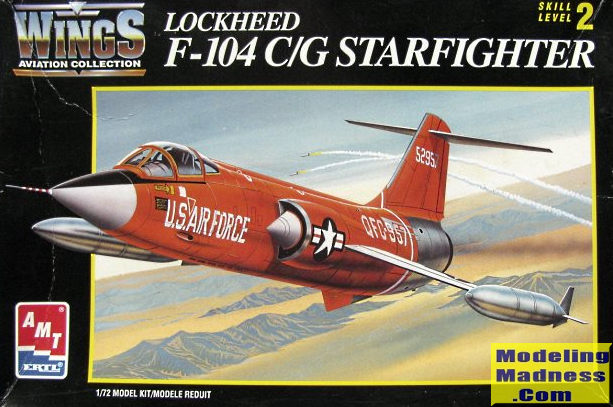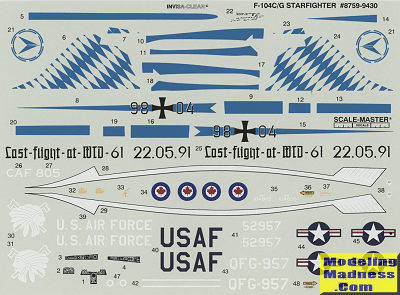
AMT 1/72 F-104C/G Starfighter
| KIT #: | 8759 |
| PRICE: | $10.00 'used' |
| DECALS: | Three options |
| REVIEWER: | Scott Van Aken |
| NOTES: | Reboxed ESCI kit from 1994 |

| HISTORY |
The Starfighter was developed as an interceptor; an aircraft whose task was to get off the ground as quickly as possible and intercept incoming bombers. To that specification, the smallest airframe possible was wrapped around the most powerful jet engine of the time, the J-79. The aircraft really was a minimalist design armed with a single 20mm Vulcan canon and two wingtip mounted Sidewinders. The unusually small wing meant a very high wing loading and so the aircraft was tricky to fly and even more tricky to land.
While used by one USAF wing, the type did not see a lot of widespread use and after the type did a tour or two in Vietnam, it was quickly pawned off on the Air National Guard, some units using it for a rather long time.
However, Lockheed was busy and wanted to make money from the planes so a fighter bomber version with wing pylons and additional fuselage mounted missile rails along with a broader rudder and improved avionics was chosen by a number of NATO countries to replace Sabres and Thunderjets. This move was particularly troublesome where what was essentially a 'country club' air force found the hot F-104 to be a plane that required their full attention. Losses and pilot deaths were especially high in the beginning before the Bundesluftwaffe initiated an intensive retraining program, after which the F-104 accident rate fell to extremely low levels.
| THE KIT |
ESCI kits generally were either very nice, or horrible. For instance, their 1/72 A-7 is a beauty while the same plane in 1/48 is a nightmare. While I've not built an ESCI 1/48 Starfighter, I have built this kit a few times and it is a beauty. Not a ton of detail, but with nicely engraved panel lines, an adequate cockpit with a choice of seats and decals for instruments and separate tail sections as the C and G are different in this area.
Due to the thinness of the wings, there are slots in the lower wings for the pylons. If your model doesn't need wing pylons (and none of the markings options in this boxing have them) you'll need to fill them. Main gear wells are molded into the fuselage halves with a separate nose gear well. Intakes are more than adequate as one cannot see far down them on a 104. Two styles of nose gear door are included and one will have to do a bit of cutting for the main gear doors. The kit includes a separate small sprue that have the CF-104 RHAW antennas. You can also model the speed brakes open or closed. Canopy is a single piece so if you want an open canopy, you will have to cut it. You can also build the model gear up, though you'll need to provide your own stand.
 Instructions
are well done and color information is generic with FS 595 references.
Interestingly, the 'aluminum' for the Canadian and German options is actually
light aircraft grey. As you might surmise, the box art plane is a QF-104C in
overall fluorescent orange with white wings. There is also a WTD 61 'Last
Flight' scheme in white with the upper wings in red, yellow, and black, which
must be painted. Also in an overall red CF-104 from 421 squadron. Decals are by
Scalemaster and typically, the red in the insignia is off register. This has
been a major issue with kits using these decals since day one and may well be
why Scalemaster went out of business. The rest of the decals are usually very
good and even with these being 23 years old, should work with no fuss.
Instructions
are well done and color information is generic with FS 595 references.
Interestingly, the 'aluminum' for the Canadian and German options is actually
light aircraft grey. As you might surmise, the box art plane is a QF-104C in
overall fluorescent orange with white wings. There is also a WTD 61 'Last
Flight' scheme in white with the upper wings in red, yellow, and black, which
must be painted. Also in an overall red CF-104 from 421 squadron. Decals are by
Scalemaster and typically, the red in the insignia is off register. This has
been a major issue with kits using these decals since day one and may well be
why Scalemaster went out of business. The rest of the decals are usually very
good and even with these being 23 years old, should work with no fuss.
| CONCLUSIONS |
Not difficult to find nor expensive, it will make into a very nice model that just about anyone will be satisfied building. If you want more detail, get the Hasegawa kit.
April 2017
Copyright ModelingMadness.com. All rights reserved.
If you would like your product reviewed fairly and fairly
quickly, please
contact
the editor
or see other details in the
Note to
Contributors.
Back to the Main Page
Back to the Review Index Page
Back to the Previews Index Page